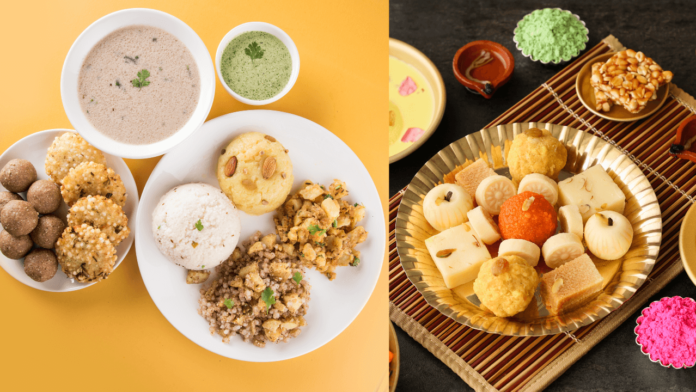Navratri is one of the most celebrated festivals in India, dedicated to Goddess Durga and her nine forms. In 2025, Shardiya Navratri begins on September 22, 2025. Along with rituals and pujas, fasting is an important part of these nine days. But fasting in Navratri is not just about skipping meals — it’s about cleansing the body, mind, and soul by choosing the right foods.
Here’s a complete guide to Navratri fasting rules, what you can eat, what to avoid, and the surprising health benefits it brings.
Basic Rules of Navratri Fasting
While customs differ across families and regions, there are a few common rules that most devotees follow:
- No non-vegetarian food – meat, eggs, fish, and alcohol are strictly avoided.
- No onion and garlic – they are believed to generate heat and are avoided during sattvik fasting.
- No regular grains or pulses – rice, wheat, and dals are usually replaced with vrat-friendly alternatives.
- Use rock salt (sendha namak) instead of regular table salt in all preparations.
What You Can Eat During Navratri Fast
Navratri vrat comes with its own special food list. These ingredients are not only delicious but also light on digestion and energizing:
- Flours for fasting: Buckwheat flour (kuttu ka atta), water chestnut flour (singhara atta), and amaranth flour (rajgira atta). These can be used for making rotis, puris, and halwa.
- Millets and pseudo-grains: Barnyard millet (sama ke chawal) or little millet can replace rice in khichdi, pulao, or kheer.
- Sabudana (tapioca pearls): Perfect for khichdi, vadas, or kheer.
- Root vegetables: Potatoes, sweet potatoes, pumpkin, bottle gourd, and colocasia are filling and easy to cook.
- Fruits and dairy: Fresh fruits, milk, curd, buttermilk, and paneer keep you full and energized.
- Spices: Rock salt, cumin, black pepper, lemon, and green chilies are commonly used for vrat recipes.
What to Avoid
During the nine days of Navratri fasting, you should stay away from:
- Meat, eggs, alcohol, and tobacco.
- Onion, garlic, mushrooms, and other tamasic foods.
- Regular grains like rice and wheat.
- Lentils, beans, and pulses.
- Packaged, processed snacks — even if labeled as vrat-friendly, they often contain excess sugar, oil, or additives.
Health Benefits of Navratri Fasting
Fasting during Navratri is more than just a tradition. If done right, it can have amazing health benefits:
- Detoxification: Eating simple, sattvik food gives your digestive system a break and helps flush out toxins.
- Weight management: Since meals are lighter, many people experience better metabolism and controlled weight.
- Improved digestion: Fruits, milk, and fiber-rich foods keep your gut healthy.
- Boosts immunity: Fresh, natural foods strengthen the immune system.
- Mental clarity: Avoiding heavy foods helps reduce sluggishness, keeping you more focused and calm.
Tips for a Healthy Navratri Fast
- Drink plenty of water, coconut water, or buttermilk to stay hydrated.
- Balance your meals with carbs (millets, kuttu), protein (paneer, nuts), and fiber (fruits, veggies).
- Avoid overeating fried snacks and sweets — moderation is key.
- Prefer steamed, roasted, or boiled foods over deep-fried options.
- Listen to your body — if you feel weak or unwell, adjust your fasting style.
Sample Navratri Fasting Menu
- Morning: Warm water with lemon + a banana or apple.
- Lunch: Sama rice khichdi with curd.
- Evening snack: Roasted sweet potato or sabudana khichdi.
- Dinner: Kuttu roti with aloo-tamatar curry and a glass of buttermilk.
Final Thoughts
Navratri fasting is not just about devotion, it’s also about discipline and mindful eating. By following the right rules, eating sattvik food, and staying hydrated, you can experience both spiritual upliftment and health benefits.
This Navratri 2025, embrace the tradition of fasting as a way to purify your body, calm your mind, and connect with the divine.
